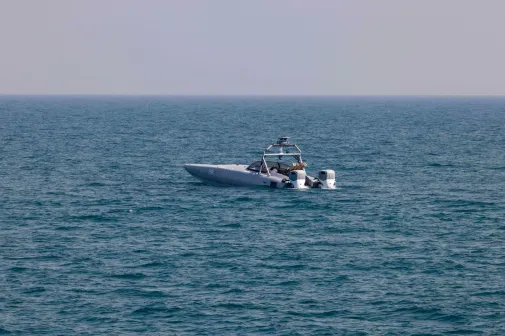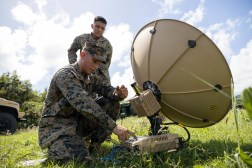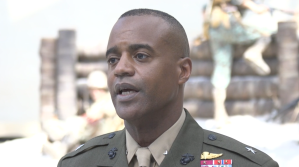Here’s what the new information warfare command in the Pacific is doing

SAN DIEGO, Calif. — As the entire Department of Defense is beginning to grapple with the outsized importance of the holistic information environment, the Navy’s Pacific Fleet determined it needed its own information command to integrate these critical capabilities.
Officials want to use info-ops to shape conditions and public and international perceptions during day-to-day competition below the threshold of conflict, deter actions that might lead to war, and achieve other operational benefits.
“I often get asked: Why did the U.S. Pacific Fleet stand up a flag-level command focused on information warfare? The answer is that Adm. [Samuel] Paparo [commander of the fleet] directed the stand up of this command, based on his experience of effectively executing information operations in the U.S. Central Command when he was the J3 — a recognition of how the world has changed and made information much more accessible, and a realization at how aggressively our primary competitor China was operating in the information domain,” Rear Adm. Michael Vernazza, commander of Fleet Information Warfare Command Pacific (FIWC PAC) and Information Warfare Task Force Pacific, said during a presentation at the annual WEST conference in San Diego Wednesday.
FIWC PAC was created about a year ago and seeks to integrate information capabilities into the fleet.
Especially in the Pacific, there is a greater need to harness the power of information, officials say.
“What strikes me is the common denominator of the information space,” Lt. Gen. George Smith Jr., commander of I Marine Expeditionary Force, said at the conference responding to a question asking what lessons have been learned from operations and assistance efforts in Afghanistan, Iraq and recently in Ukraine, that could apply to a fight with China related to Taiwan.
“You can have all the tactical successes you want and we certainly had a bunch of them in the examples you gave. And Ukraine is yet another example. But if you’re not winning in the information space, you’re not winning. I see that as a common denominator going forward in a China-Taiwan scenario as well,” he added.
Vernazza said Pacific Fleet saw the need for a command and a task force to operate and maneuver in the information space to support other Echelon III fleets to achieve desired information end states.
“‘Information operations will be baked into everything we do’ is the guiding principle for the U.S. Pacific Fleet, and the development of operations activities and investments. We start with what is the right message, the desired information and perception end state, and then we design operations activities and investments with that in mind,” he said.
With the creation of the new command, information operations are getting much more visibility and focus in theater, Vernazza said, and personnel are working with other components across other services to integrate their messages.
FIWC PAC’s efforts are also going to be used as a template of sorts to inform activities of other Naval organizations around the world.
“It’s going to inform what we do at all the other number fleets and [maritime operations center] level in terms of IW integration where we really need to commit to a construct, so that the [information] boss and the rest of IW can align and delivering the best capability. We’re on that path,” Vice Adm. Kelly Aeschbach, commander of Naval Information Forces, said at the conference.
The command bases its information operations loosely on the highly successful processes pioneered by Joint Special Operations Command in Iraq for mapping, tracking and targeting al-Qaeda’s network in the counterinsurgency fight through a process known as find, fix, finish, exploit and analyze.
FIWC PAC calls their process the information effects cycle, and it’s how they integrate into Pacific Fleet to rapidly identify, plan, execute and assess information operations in a timely way.
Part of what the command is trying to do is beat back adversaries’ actions in the information sphere that seek to shape public and international perceptions.
“While the information age has been net positive, it has also provided malign actors numerous new outlets and mediums to spread disinformation, propaganda and lies. Our ability to influence is critical across the spectrum of conflict, competition and crisis. Why is that?” Vernazza asked. “Because malign actor nations in the information space rely on deniability and they seek to remain below the response threshold and achieve cumulative effects through seemingly minor actions.”
One of the key pillars of the new national defense strategy outlines the notion of integrated deterrence. It also highlights the key role of information in that mission.
“Deterrence depends in part on competitors’ understanding of U.S. intent and capabilities. The Department must seek to avoid unknowingly driving competition to aggression. To strengthen deterrence while managing escalation risks, the Department will enhance its ability to operate in the information domain — for example, by working to ensure that messages are conveyed effectively. We will work in collaboration with other U.S. Federal departments and agencies along with Allies and partners,” the document said in a section about the role of information in deterrence.
The strategy notes that tailored information operations can be used to support and maybe even lead the DOD’s response to adversaries’ coercion attempts.
For Vernazza and FIWC PAC’s mission, marrying deterrence and information can alter competitors’ perceptions of risk, costs and benefits, and demonstrate friendly forces’ ability to control escalation.
“In deterrence, information operations is … baked into everything we do,” he said. “Information warfare and specifically information operations is designed to influence and affect cognitive states and reinforce the perception and belief that the cost of imposition of aggressive expansionism, coercion and military actions will exceed any benefits that can be gained through aggression.”
Some of the activities they do to achieve this include theater security cooperation, exercises, freedom of navigation activities, key leader engagements and military information support operations (MISO), which is what the military calls psychological operations. Through MISO, they share and disclose adversary activity with partners and news media.
“Competing in the information environment is about ensuring that we, as free and sovereign nations, ensure our competitors’ behaviors are held to account and that we illuminate the true nature of their activities and illustrate the cumulative effects of their actions,”Vernazza said. “More importantly, that our competitors actions do not disrupt the peace and stability of the Indo-Pacific region or the international rules-based order and international system that has resulted in decades of shared prosperity. This raises the importance of combating a competitor’s narrative, not just its tactical actions.”






